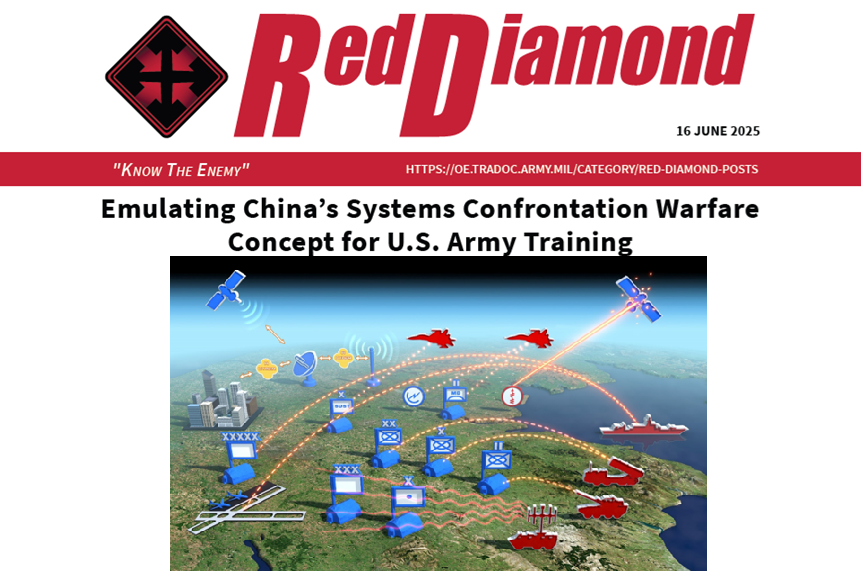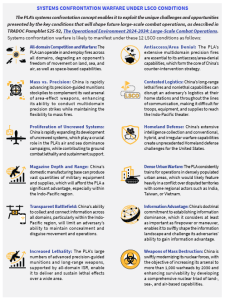
Emulating China’s Systems Confrontation Warfare Concept for U.S. Army Training
By Kevin Freese
Exploring China's "systems confrontation" – a high-tech approach to modern warfare.
After observing the U.S. military’s performance in the first Gulf War, Chinese military theorists concluded that advanced weapons and equipment have changed the character of armed conflict, leading the People’s Liberation Army (PLA) to develop an approach to warfare known as ‘systems confrontation.’ 1 Since then, the PLA has refined and evolved its new concept, but the underlying principle remains consistent—warfare as confrontations between integrated, high-technology systems using joint forces across all domains of warfare, rather than engagements between individual units or combined-arms maneuver formations.2 Systems include individual elements joined to form a greater whole, and systems themselves can join to form systems of systems. All systems depend upon critical nodes, which, if disrupted, will render it ineffective.
The primary objective of systems confrontation is to paralyze the enemy by disabling what the PLA identifies as the five critical military operational systems: command, firepower-strike, information, intelligence, and support. Rather than focusing on destroying individual units or platforms, systems confrontation seeks to render the enemy’s operational systems ineffective.3 By targeting systems, the enemy is prevented from coordinating and supporting its forces, leading to isolation on the battlefield. Once isolated, the attacker can surround and annihilate unsupported formations that have been rendered combat ineffective. The tools used in systems confrontation warfare should already be familiar to U.S. Army Soldiers because they are represented in tactical doctrine. The U.S. Army employs one or more of the four defeat mechanisms—destroy, disintegrate, isolate, and displace4—to prevent enemy forces from achieving their objectives, which closely parallels the PLA’s principles of systems confrontation warfare.5
Systems confrontation warfare relies on PLA forces’ ability to focus attacks against key nodes—connection points essential to the enemy’s operational systems. Chinese forces prefer to attack weak but vital nodes where they have a relative advantage. These focused attacks are executed through a combination of “soft” and “hard” fires, including cyber and electromagnetic warfare with lethal fires.6 Nonlethal means may be the main effort, with lethal fires as the supporting effort.
The PLA does not limit its warfare domain concept to the same domains as the U.S. military. In addition to land, sea, air, space, and cyber; Chinese forces consider the cognitive dimension and electromagnetic spectrum to be domains.

The PLA aims to neutralize the enemy’s ability to fight by targeting the most critical operational systems, focusing first on command and control to paralyze decision making and disrupt communications. As depicted in Figure 1, likely targets at each echelon include command posts and headquarters, which the PLA may attack kinetically based on electronic and other signatures, as well as through nonlethal means such as electronic warfare (EW) and cyberspace attacks. After disabling command systems, the PLA will target high-tech weapon systems, then support systems, and finally seek to undermine enemy morale.7 Information systems are especially vital because Chinese forces view the information network
as the central nervous system of the fighting force, making it a top priority in systems confrontation.


Implications for U.S. Army Training
Systems confrontation can be faithfully emulated by OPFOR in exercises to help U.S. Army units better understand and defeat adversaries using a similar operational approach.
–An OPFOR emulating systems confrontation warfare would target key network nodes and weak points to isolate and destroy them, disintegrating specific systems rather than formations. By targeting weak nodes in key systems—C2, intelligence, fires, and logistics—the OPFOR would deny the Blue force the ability to establish a common operating picture, communicate intent to subordinate commands, employ forces in a mutually supporting manner, and sustain operations. For an OPFOR using a systems-confrontation approach, seizing and holding key terrain is secondary to achieving desired effects upon key Blue force nodes.
–The OPFOR would also target the Blue force’s decision making by influencing its commander in the cognitive domain. In such a scenario, the OPFOR would lead with cognitive warfare to confuse the Blue force commander by restricting access to accurate and timely information and provide false and misleading information. The goal would be to cause the commander to make poor decisions and demoralize the fighting force.
–The OPFOR would then try to target the Blue force’s advanced weapons systems to interdict fires early in the fight through lethal and nonlethal means. Soft kills would focus on blinding sensors or disrupting communications, while hard kills would use long-range precision munitions, prioritizing the most sophisticated Blue systems. OPFOR would try to overwhelm Blue’s fires in terms of quality (i.e., exquisite systems) and quantity (e.g., drone swarms and massed fires).
ENDNOTES
1 Jeffrey Engstrom, Systems Confrontation and System Destruction Warfare: How the Chinese People’s Liberation Army Seeks to Wage Modern Warfare (Santa Monica, CA: RAND Corporation, 2018). https://www.rand.org/pubs/research_reports/RR1708.html. Also available in print form.
2 Yuliang Zhang, et al., Science of Campaigns, trans. CASI and Project Everest (Maxwell AFB: Air University, 2020), 407-410.
3 Tianliang Xiao, et al., Science of Military Strategy, trans. CASI (Maxwell AFB: Air University, 2022), 262-273.
4 Department of the Army, Operations ADP 3-0 (Washington, D.C.: Headquarters, Department of the Army, 2019), 2-4 – 2-5.
5 Ibid
6 Rongren Ji et al., Services and Arms Application in Joint Operations, trans. CASI and Project Everest (Maxwell AFB: Air University, 2021), 27-29.7 Rongren Ji et al., Services and Arms Application in Joint Operations, trans. CASI and Project Everest (Maxwell AFB: Air University, 2021), 25-27.
8 Jeffrey Engstrom, Systems Confrontation and System Destruction Warfare: How the Chinese People’s Liberation Army Seeks to Wage Modern Warfare (Santa Monica, CA: RAND Corporation, 2018). https://www.rand.org/pubs/research_reports/RR1708.html. Also available in print form.
Distribution A: Approved for public release
Categories:
Tags:
Emulating China’s Systems Confrontation Warfare Concept for U.S. Army Training
By Kevin Freese
File Size:
1.93 MB
File Type:
Page Count:
5

